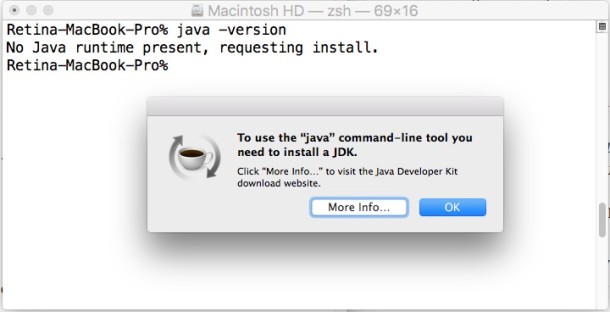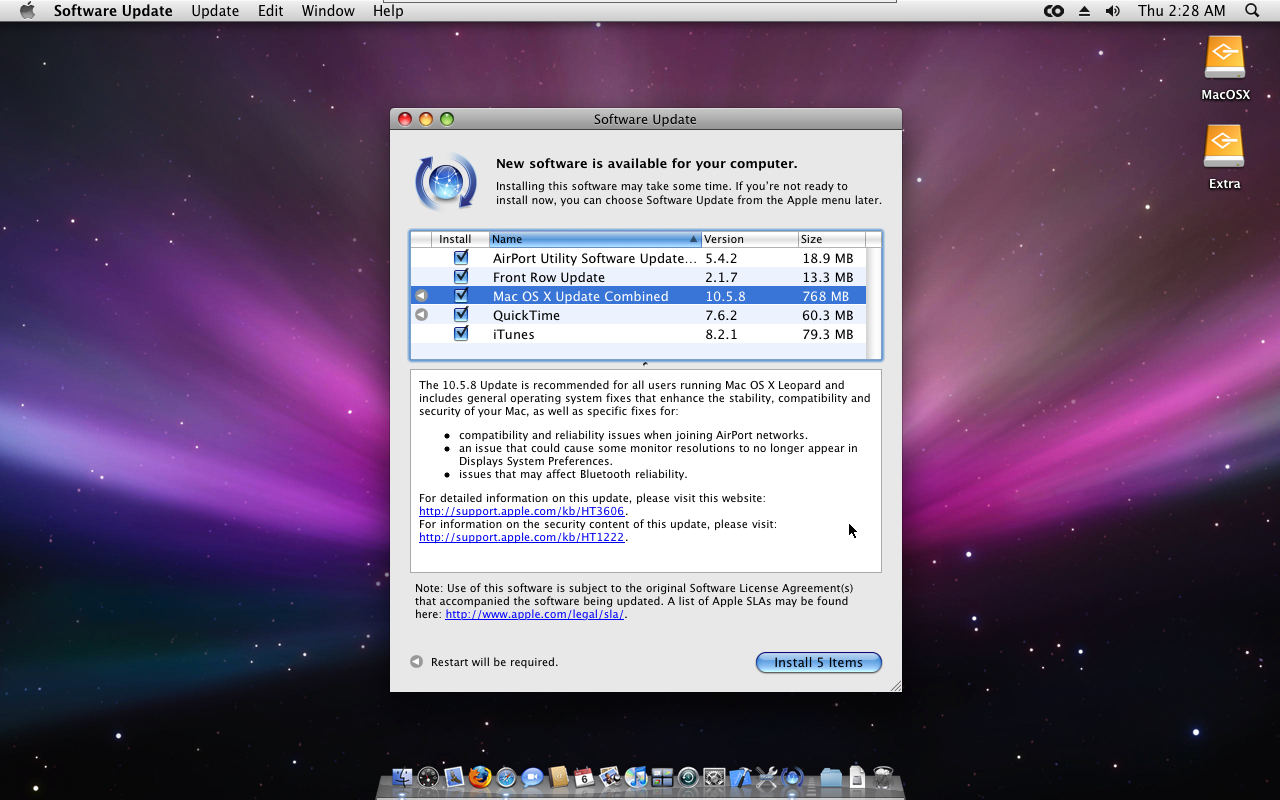How to install Java JDK (Java Development kit 12) on Mac OS. Download and install Java on Mac OS X. We will also update the JAVAHOME environment variable ne. The Apple Java for OS X 2012-006 1.0 update for Mac OS X 10.7, 10.8 operating systems delivers improved security, reliability, and compatibility by uninstalling the Apple-provided Java applet plug. Java SE Development Kit 8 1.8 for Mac is free to download from our application library. The actual developer of this free software for Mac is Oracle. The program lies within Developer Tools, more precisely General. Our built-in antivirus checked this Mac download and rated it as 100% safe.
Apple vetted Java environment, designed to be as highly integrated as possible within its own operating system and to improve security, reliability, and performance
What's new in Java for Mac OS X 2017-001:
Java Mac Os X Version 10.6 8 Download
- This package is exclusively intended for support of legacy software and installs the same deprecated version of Java 6 included in the 2015-001, 2014-001, and 2013-005 releases.
Java for OS X is an Apple vetted Java environment, designed to be as highly integrated as possible within its own operating system. Java for OS X has been created to mix OS X's advanced technologies and Java's adaptability and omnipresence on almost all software platforms out there.
The newer Java packages are maintained by Oracle, therefore it is recommended to use Oracle's Java JRE.
Furthermore, it also brings an astounding amount of new applications to the Mac platform, all ready to use and compatible with all macOS releases, past and present.
Java for OS X follows the “Write once, run anywhere” tag line of the Java runtime and this means that developers do not need to make any type of adaptations or modifications to their Java apps in order for them to run on a Mac computer.
Because Java for OS X is so easy installable and the operating system will notify you to install it right away the first time you're trying to run a Java application on your Mac, developers that use it to create their applications can start distributing them on the Mac platform right away.
On account of Java being the only framework with an embedded graphical toolkit, besides Cocoa, Java apps can be designed to provide Mac users with interfaces almost identical to those available in native OS X applications.
Thus, if the developer takes the time to make sure that the OS X look is set as the default for utilities distributed on the OS X platform, the end user will not be able to know if they are built using Java or not.
Jdk 1.8 Mac Download
Java for OS X also comes with a Control Panel that can be opened via the System Preferences window, using the Java preferences pane. This panel enables you to adjust the runtime network settings, as well as manage the temporary internet files stored by Java on your Mac's hard drive.
Using the same panel, you can also check for newer versions of Java and view and manage the Java runtime versions installed on your Mac via the Java Runtime Environment Settings window.
The Control Panel will also enable you to manage more advanced options related to Application Installation, Secure Execution Environment, Java Console, Debugging and a host of Advanced Security Settings related to certificates and data transfer encryption.
All things considered, Java for OS X is the thing that makes it possible for any application created using the Java framework to run on any Mac, with an interface that makes it look like a native app.
Filed under
Java for Mac OS X was reviewed by Sergiu GatlanJava for Mac OS X 2017-001
Softpedia Editor's Pickadd to watchlistsend us an update- runs on:
- Mac OS X 10.7 or later (Intel only)
- file size:
- 51.1 MB
- filename:
- JavaForOSX.dmg
- main category:
- System Utilities
- developer:
- visit homepage
top alternatives FREE
top alternatives PAID
This page describes how to install and uninstall JRE 8 on OS X computers.
Note: The JRE installation includes the JavaFX Runtime which is incorporated into the same directory structure. |

This page has these topics:
See 'JDK 8 and JRE 8 Installation Start Here' for general information about installing JDK 8 and JRE 8.
See 'OS X Platform Install FAQ' for general information about installing JRE 8 on OS X.
System Requirements
Observe these requirements:
Any Intel-based computer running OS X 10.8 (Mountain Lion) or later.
Administrator privileges.
Note that installing the JRE on OS X is performed on a system-wide basis, for all users, and administrator privileges are required. You cannot install Java for a single user.
Only one JRE can be installed at a time. The system will not install a JRE that has a lower version than the current version. If you wish to install a lower version of the JRE, uninstall the current version as described in 'Uninstalling the JRE'.
Installing a JRE from Oracle will not update java -version symlinks or add java to your path. To be able to do this, you need to install the JDK.
JRE Downloaded File
Depending on your processor, the downloaded file has one of the following names, where version is the update number:
jre-8uversion-macosx-amd64.dmgjre-8uversion-macosx-x64.dmg
Download Java For Mac Os X
Installing JRE 8u40
If you are installing JRE 8u40, then follow these steps:
Download the file.
Before the file can be downloaded, you must accept the license agreement.
From either the Downloads window of the browser, or from the file browser, double click the file
.dmgto launch it.A Finder window appears containing an icon of an open box and the name of the
.appfile.Double click the package icon to launch the Install app.
A window appears that says, 'Java 8 Update 40 is trying to install a new helper tool. Type your password to allow this.'
Enter the Administrator login name and password and then click Install Helper.
The Install app then displays the Introduction window.
Click Next.
Oracle has partnered with companies that offer various products. The installer may present you with the option to install these programs when you install Java. Specify if you want these programs installed and then click Next.
Note:
You can disable the presentation of offers during installation by specifying the--args SPONSORS=0option in the terminal command line. For example:open /Volumes/Java 8 Update 40/Java 8 Update 40.app --args SPONSORS=0An Installation Progress window is displayed. Once the software is installed, a confirmation window appears and then an applet is launched to verify the version of Java installed.
Delete the
.dmgfile if you want to save disk space.
Determining the Installed Version of the JRE
If you have not yet installed Apple's Java OS X 2012-006 update, then you are still using a version of Apple Java 6 that includes the plug-in and the Java Preferences app. See 'Note for Users of OS X that Include Apple Java 6 Plug-in'.

Only one JRE can be installed. Installing a JRE removes the previously installed JRE. The JRE version used by the system can be determined in one of two ways:

From System Preferences click the Java icon from the Other category. This launches the Java Control Panel. Click About.
Type the following in a Terminal window (note escaped space character, ignore line break):
The system will not install a JRE that has a lower version than the current version. If you want to install a lower version, first uninstall the existing version.
Uninstalling the JRE
To uninstall the JRE, you must have Administrator privileges and execute the remove commands either as root or by using the sudo(8) tool.
Remove one directory and one file (a symlink), as follows:
Navigate to
/Library/Internet Plug-Insand remove theJavaAppletPlugin.plugindirectory.Navigate to /
Library/PreferencePanesand removeJavaControlPanel.prefpane.
Download Java 8 Mac Os X
Do not attempt to uninstall Java by removing the Java tools from /usr/bin. This directory is part of the system software and any changes will be reset by Apple the next time you perform an update of the OS.